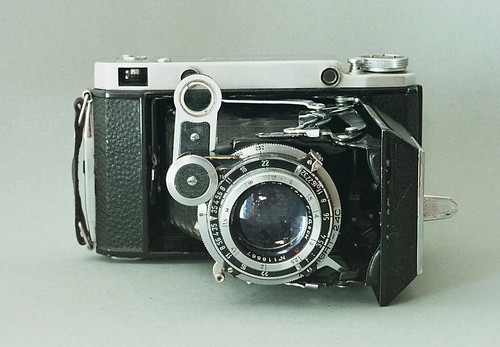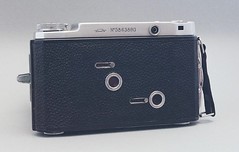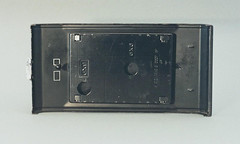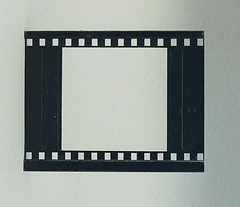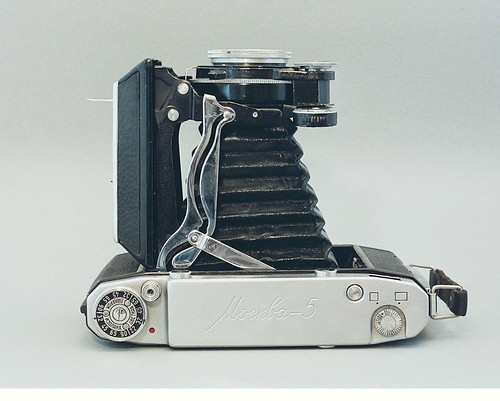Difference between revisions of "Moskva-5"
m (→Links) |
m (correcting link to edited picture) |
||
| Line 10: | Line 10: | ||
The '''Moskva-5''' (MOCKBA-5 in cyrillic writing) was produced by [[KMZ]] (''Krasnogorskii Mechanicheskii Zavod'' or Krasnogorsk Mechanical factory) in the 1950s. Earlier models of the [[Moskva]] were copies of the [[Zeiss Ikon]] [[Ikonta#Super_Ikonta_rangefinder_cameras|Super Ikonta C]], but it makes more sense to call the Moskva-5 an adaptation. Unlike the Super Ikonta, its solid top plate has a built-in [[rangefinder (device)|rangefinder]] and a dual-format [[viewfinder]]. The best thing about the Moskva-5 is the ''coupled'' rangefinder. A lever with rotating wedge-shaped prisms is fixed to the lens plate. Turning the lens to focus rotates the glass, thus adjusting the rangefinder: a very sophisticated device inherited from the Super Ikonta, with no mechanical linkage between the lens and the body. The two windows are 6.5 cm apart for accurate focusing. The separate viewfinder has a larger field of view, which helps composing the picture. As stated above, a sliding frame in the viewfinder selected on top of the camera can be set to 6×9 or 6×6. | The '''Moskva-5''' (MOCKBA-5 in cyrillic writing) was produced by [[KMZ]] (''Krasnogorskii Mechanicheskii Zavod'' or Krasnogorsk Mechanical factory) in the 1950s. Earlier models of the [[Moskva]] were copies of the [[Zeiss Ikon]] [[Ikonta#Super_Ikonta_rangefinder_cameras|Super Ikonta C]], but it makes more sense to call the Moskva-5 an adaptation. Unlike the Super Ikonta, its solid top plate has a built-in [[rangefinder (device)|rangefinder]] and a dual-format [[viewfinder]]. The best thing about the Moskva-5 is the ''coupled'' rangefinder. A lever with rotating wedge-shaped prisms is fixed to the lens plate. Turning the lens to focus rotates the glass, thus adjusting the rangefinder: a very sophisticated device inherited from the Super Ikonta, with no mechanical linkage between the lens and the body. The two windows are 6.5 cm apart for accurate focusing. The separate viewfinder has a larger field of view, which helps composing the picture. As stated above, a sliding frame in the viewfinder selected on top of the camera can be set to 6×9 or 6×6. | ||
<div> | <div> | ||
| − | [http://www.flickr.com/photos/50678983@N00/162263471/in/pool-camerapedia/ http://static.flickr.com/50/ | + | [http://http://www.flickr.com/photos/50678983@N00/162263471/in/pool-camerapedia/ http://farm1.static.flickr.com/50/162263471_85eb34053d_m.jpg] |
</div> | </div> | ||
The back of the camera showing the year of production (1958), two [[red window]]s for 6×6 and 6×9 numbering, the rangefinder window (left) and the separate viewfinder window (right). The symbol to the left of the serial number is the Krasnogorsk company logo. | The back of the camera showing the year of production (1958), two [[red window]]s for 6×6 and 6×9 numbering, the rangefinder window (left) and the separate viewfinder window (right). The symbol to the left of the serial number is the Krasnogorsk company logo. | ||
Revision as of 09:38, 31 January 2010
Contents
Description
The Moskva-5 (MOCKBA-5 in cyrillic writing) was produced by KMZ (Krasnogorskii Mechanicheskii Zavod or Krasnogorsk Mechanical factory) in the 1950s. Earlier models of the Moskva were copies of the Zeiss Ikon Super Ikonta C, but it makes more sense to call the Moskva-5 an adaptation. Unlike the Super Ikonta, its solid top plate has a built-in rangefinder and a dual-format viewfinder. The best thing about the Moskva-5 is the coupled rangefinder. A lever with rotating wedge-shaped prisms is fixed to the lens plate. Turning the lens to focus rotates the glass, thus adjusting the rangefinder: a very sophisticated device inherited from the Super Ikonta, with no mechanical linkage between the lens and the body. The two windows are 6.5 cm apart for accurate focusing. The separate viewfinder has a larger field of view, which helps composing the picture. As stated above, a sliding frame in the viewfinder selected on top of the camera can be set to 6×9 or 6×6.
The back of the camera showing the year of production (1958), two red windows for 6×6 and 6×9 numbering, the rangefinder window (left) and the separate viewfinder window (right). The symbol to the left of the serial number is the Krasnogorsk company logo.
Dual Format
Super Ikontas were made either for the 6×9 or 6×4.5 format. The Moskva-5 is a 6×6 and 6×9 camera. Since it has a fixed 105mm Industar lens, at 6×6 you have a mild tele at your disposal. To use the 6×6 size, you need to set the viewfinder to the square format. The film pressure plate is taken off to select the right window so you can see the numbering on the film back. The 6×9 red window is now blocked, so there's no room for confusion.
As a last step, the 6×6 mask has to be inserted. The camera locks right into its holes. Close the camera and you're ready to shoot.
Operation
The Moment 24c is a leaf shutter with speeds of B, 1 to 1/250s. To fire it, the film needs to be transported or the release button will be blocked, indicated by a red window on the top plate. The shutter isn't set by advancing the film; it has to be cocked at the lens by a lever. To take a picture, press the button on the left of the camera top. The button on the right is for unlocking the front plate when the camera is collapsed. Before folding the camera, you shouldn't forget to push down the lever with the polarised glass window.
Links
- Tips for using the Moskva
- Moskva 5 at Robert Monaghan's Medium Format Photography Megasite
- Locating light leaks in a Moskva 5 at Nelsonfoto forums
- Fixing light leaks (in french) at Dirapons'site
- Moskva 5 on www.collection-appareils.fr by Sylvain Halgand

